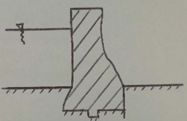This set of Basic Civil Engineering Multiple Choice Questions & Answers (MCQs) focuses on “Dams”.
1. Which of the below is the earliest known dam?
a) Sadd-el-Kafara dam
b) Dam of Marib
c) Jawa Dam
d) Ha-ilar Dam
View Answer
Explanation: Jawa Dam is in Jordan. It is 100 kms northeast of capital Amman. It is a gravity dam with stone wall. It is dated to 3000 BC.
2. Portion of dam in contact with ground at downstream side is __________
a) Crest
b) Toe
c) Foot
d) Heel
View Answer
Explanation: Toe is the position of a dam in contact with the ground at the upstream side. Crest is top of dam. There is no part called a foot.
3. Based on function of dam, it can be classified into: –
a) 5
b) 8
c) 10
d) 6
View Answer
Explanation: The five types are storage, diversion, detention, debris and coffer dams.
4. The cross section below shows a

a) Earth
b) Buttress
c) Gravity
d) Arch
View Answer
Explanation: The figure shows a gravity dam. It is a massive sized dam built using concrete or stone masonry. They can hold back large volume of water.
5. Which of the below is an example for earth dam?
a) Bhakra Nangal Dam
b) Banasura Sagar Dam
c) Idukki Dam
d) Bisalpur Dam
View Answer
Explanation: Bhakra Nangal Dam is an example of gravity dam. Idukki dam is an arch dam. Bisalpur Dam is also a type of gravity dam.
6. ___________ is the arrangement made near top of dam for passage of excess water from the reservoir.
a) Sluice way
b) Spillway
c) Gallery
d) Abutments
View Answer
Explanation: Spillway is kind of a passage to allow water from upstream side to downstream side of a dam. They have floodgates to control the flow.
7. Hydroelectric power plants at dam supplies about _________ of world’s electricity.
a) 19%
b) 25%
c) 42%
d) 50%
View Answer
Explanation: It also contributes to over 63% of renewable energy. Most of this is generated by China (large dams) and contributes about 50% of world use of the power generated.
8. Natural dam is not created usually by:
a) Glacial activity
b) Volcanic activity
c) River meandering
d) Moraine deposit
View Answer
Explanation: River meandering refers to the formation of a member by a river by altering its straight course and following a sinuous winding path. It can’t form a dam naturally. Volcanic dams form when lava flows and intercepts a river or lake, resulting in a natural impoundment. Glacial activity and moraine deposits can also form dams.
9. Arch-gravity dams are thinner dams and save resources.
a) True
b) False
View Answer
Explanation: It is a combination of arch and gravity dam. It is inward compression by water reduces lateral force acting on dam. Gravitational force required is less. Hence, it saves resources and doesn’t need to be massive.
10. Buttress dams are of __________ types.
a) 6
b) 4
c) 8
d) 3
View Answer
Explanation: The three types of buttress dam are deck type, multiple-arch type and massive-head type. Deck type consists of a sloping deck supported by buttresses. In massive-arch type, deck is replaced by horizontal arches. There is no deck slab in massive-head type.
11. _________ is a temporary dam constructed to exclude water from a specific area.
a) Debris dam
b) Diversion dam
c) Coffer dam
d) Storage dam
View Answer
Explanation: Coffer dam is constructed on the upstream side of the site where a dam is to be constructed, so that site is dry.
12. Based on material of construction, ___________ types are there.
a) 2
b) 4
c) 6
d) 8
View Answer
Explanation: There are two types – rigid and non-rigid. Rigid material includes steel, concrete, masonry, stone, etc. and non-rigid materials are earth (earth dam), tailings (waste from mine), rock fill (rock).
13. Earth dams are _________ in shape.
a) Triangular
b) Rectangular
c) Trapezoidal
d) Circular
View Answer
Explanation: Earth dams are generally built using gravel, sand and clay. They are trapezoidal in shape so as to hold the non-rigid materials properly.
14. Hydraulic head for a small dam is:
a) 5-7.5m
b) 7.5-12m
c) 12-13m
d) 5-10m
View Answer
Explanation: Based on size, there are three types of dam. Small with hydraulic head 12-15m, intermediate with 12-30m and large with greater than 30m.
Sanfoundry Global Education & Learning Series – Basic Civil Engineering.
To practice all areas of Basic Civil Engineering, here is complete set of 1000+ Multiple Choice Questions and Answers.
If you find a mistake in question / option / answer, kindly take a screenshot and email to [email protected]
